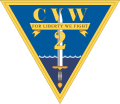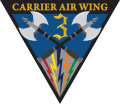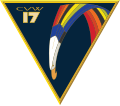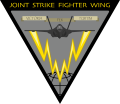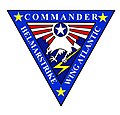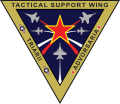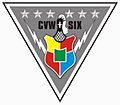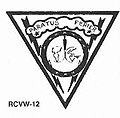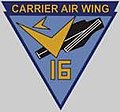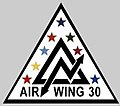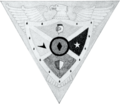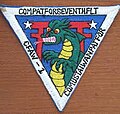Top Qs
Timeline
Chat
Perspective
List of United States Navy aircraft wings
From Wikipedia, the free encyclopedia
Remove ads
This is a list of United States Navy aircraft wings. The U.S. Navy first used the term "wing" in 1935 when patrol squadrons operating together in the same geographical area were for the first time loosely designated patrol wings, however these "wings" lacked any formal organization or headquarters staff. In 1937 the Navy's first wings were created when five Patrol Wings were formally established to exercise command of its patrol squadrons.[1] A year later it organized the squadrons flying from the five aircraft carriers in commission at the time into Carrier Air Groups. Those Carrier Air Groups established in 1938 are the forerunners of today's Carrier Air Wings. Today the U.S. Navy operates both Aircraft Carrier based Carrier Air Wings and land based Functional Wings and Type Wings. Carrier Air Wings are operational units made up of squadrons of different types of aircraft that deploy aboard aircraft carriers. The Navy's land based wings are organized either to perform a specific function (Functional Wings) or around a specific aircraft type (Type Wings). Patrol and Reconnaissance Wings, Test Wings and Training Wings are examples of functional wings, these wings may consist of a single type of aircraft or of a variety of types needed to perform a wing's specific function. Type Wings consist of squadrons of a single type of aircraft, they are non-deploying "force providers" that provide combat ready squadrons or detachments to deploying Carrier Air Wings or to other Navy or joint forces. All Navy aircraft wings whether they are Carrier Air Wings or Land Based Type or Functional Wings are commanded by a Navy Captain, however; in the case of a Training Air Wing or Naval Test Wing a U.S. Marine Corps Colonel is sometimes assigned as commander as those wings conduct training or test and evaluation for both the U.S. Navy and the U.S. Marine Corps. Commanders of Carrier Air Wings are informally addressed as "CAG" which is a hold over from the previous designation (prior to 20 Dec 1963) of Carrier Air Wings as Carrier Air Groups and commanders of functional or type wings are addressed as "Commodore" which is a traditional Naval title for an officer exercising command over multiple units commanded by Commanding Officers (individual ships or aircraft squadrons)
Remove ads
Current Navy Air Wings
Summarize
Perspective
The Navy currently operates nine Carrier Air Wings and twenty three land based Type Wings and Functional Wings.
Current Carrier Air Wings
Carrier Air Wings were first established on 1 July 1938 when the aircraft squadrons assigned to the aircraft carriers USS Lexington (CV 2), USS Saratoga (CV 3), USS Ranger (CV 4), USS Yorktown (CV 5) and USS Enterprise (CV 6) were established as "Carrier Air Groups" assigned to each of those ships. Two of those Carrier Air Groups still exist today as Carrier Air Wings ONE and THREE. On 20 December 1963 all Carrier Air Groups which were then in existence were redesignated Carrier Air Wings (CVW). Of the nine current Carrier Air Wings, two were established before WWII, four during WWII, two during the period of the Korean War and one during period of the Vietnam War. The table below lists the nine currently active Carrier Air Wings.
Active Carrier Air Wings (CVW). CVWs were titled Carrier Air Groups (CVG, CVAG, CVBG) prior to 20 Dec 1963
Note: This table may be out of date with regard to Carrier Strike Group (CSG) assignment as CVWs are not permanently assigned to a specific CSG.
- Tail codes with a first letter "A" denote Atlantic Fleet airwings, while "N" denotes Pacific Fleet airwings.
Current Type Wings
Type Wings are non-deploying "force provider" wings which provide combat ready squadrons or detachments to Carrier Air Wings or for land based or other shipboard (non-aircraft carrier) deployments. Type Wing squadrons which deploy as part of a Carrier Air Wing (CVW) are based with their Type Wing when not deployed, not with their Carrier Air Wing. The exception are those squadrons assigned to the Carrier Air Wing which is forward deployed to Japan, those squadrons are based in Japan with their Carrier Air Wing, not with their Type Wings which are all based in the United States. Type Wings also operate their aircraft's Fleet Replacement Squadron.
With one exception there are no type wing Tail Codes. Type wing squadrons which are also carrier air wing squadrons are marked with the tail code of their carrier air wing. Expeditionary squadrons and Fleet Replacement Squadrons[au] are marked with squadron unique codes. The single exception is Electronic Attack Wing Pacific (VAQWP) which has a tail code for its expeditionary squadrons.[av]
Current Functional Wings
Functional Wings are made up of squadrons of land based aircraft which serve in various operational or support roles. They may be made up of squadrons of a single type of aircraft or squadrons of various types of aircraft to accomplish their assigned function.
There are three U.S Navy Reserve Wings under the command of the Commander, Naval Air Force Reserve. Tactical Support Wing (TSW) provides 100% of the Navy's dedicated "Aggressor" squadrons[aw] and it provides one Expeditionary Electronic Attack (VAQ) squadron. Fleet Logistics Support Wing (FLSW) provides 100% of the Navy's "Navy Unique Fleet Essential Airlift" (NUFEA) aircraft providing worldwide logistics support to operating forces. Maritime Support Wing (MSW) maintains two Patrol (VP) squadrons and one expeditionary Helicopter Maritime Strike (HSM) squadron for tasking as required.
Naval Test Wing Atlantic (NTWL) and Naval Test Wing Pacific (NTWP) are Developmental Test and Evaluation (DT&E) wings. NTWL is the operational component of the Naval Air Warfare Center Aircraft Division, it is responsible for DT&E of Navy and Marine Corps aircraft and it operates the United States Naval Test Pilot School. NTWP is the operational component of the Naval Air Warfare Center Weapons Division, it is responsible for DT&E of Navy and Marine Corps airborne systems and weapons. Note: Operational Test and Evaluation (OT&E) of USN and USMC aircraft and airborne weapons is conducted by the U.S. Navy Operational Test and Evaluation Force, Aviation Warfare Division, not by NTWL or NTWP.
Strategic Communications Wing ONE reports administratively to Commander, Naval Air Force Pacific. Operationally it is designated United States Strategic Command Task Force 124 and operates airborne command and control aircraft for the relay of strategic communications to the nation's Intercontinental ballistic missile and Submarine-launched ballistic missile forces.
Patrol and Reconnaissance Wings TEN and ELEVEN report to Commander, Patrol and Reconnaissance Group.[bf] Patrol and Reconnaissance Group operates the P-8A/MQ-4C Fleet Replacement Squadron.
Training Air Wings fall under the command of the Chief of Naval Air Training. They train Student Naval Aviators (SNA) of the U. S. Navy, U. S. Marine Corps and U. S. Coast Guard and Student Naval Flight Officers (SNFO) and Air Vehicle Pilots (AVP)[bk] of the U. S. Navy. They also provide training for foreign military student aviators under the Foreign Military Sales program.
Remove ads
Disestablished Navy Air Wings
Summarize
Perspective
The tables below list wings which have been disestablished. Included in the tables are no longer used former designations of disestablished and current wings.
Disestablished Carrier Air Groups/Carrier Air Wings 1938 to present
On 1 July 1938 the first five Carrier Air Groups were established. They were the Lexington Air Group, the Saratoga Air Group, the Ranger Air Group, the Yorktown Air Group and the Enterprise Air Group (aircraft had operated from the Navy's first aircraft carrier, USS Langley from January 1923 to June 1936 but in October 1936 she was converted to a seaplane tender). Between 1 July 1938 and the end of World War II approximately 88 more airwings were established. To the present day there have been a total of 133 Carrier Air Groups (called Carrier Air Wings since 20 December 1963) established, only nine of which still exist as Carrier Air Wings. A tenth wing still exists as the U.S. Navy Reserve's Tactical Support Wing which is now a land based functional wing.
During the course of a single Carrier Air Group/Carrier Air Wing's existence it may have been identified by more than one designation. The inverse is also true in that a single designation (such as CVG-15) could have been used for multiple different Carrier Air Groups/Carrier Air Wings over time. For example, there were three carrier air groups which were designated CVG-15 at some point in each of their existence and none of those three groups were related to each other. The first was a Second World War group which existed as CVG-15 from 1 September 1942 to 30 October 1945. The second was a Carrier Air Group which was established in 1945 as CVG-153, it was redesignated CVAG-15 on 15 November 1946, then again redesignated as CVG-15 on 1 September 1948 and disestablished on 1 December 1949. The third was established as CVG-15 on 5 April 1951, redesignated CVW-15 on 20 December 1963 and disestablished on 31 March 1995. The lineage of a Carrier Air Group/Carrier Air Wing does not follow the designation, it follows the Group/Wing regardless of the designation.
Of the 133 Carrier Air Groups/Carrier Air Wings which have ever existed, 100 have been identified by a single designation, 17 have been identified by two designations, seven by three designations, six by four designations and three by five designations.
This section contains tables of disestablished Carrier Air Groups (Ship Named Groups, CVG, CVLG, CVEG, CVBG, CVAG, CVSG), Air Task Groups (ATG) and Carrier Air Wings (CVW). The tables which follow are arranged by time periods using the designation scheme which was in use during that time period. Because of this, various carrier air groups/carrier air wings will appear in multiple tables below.
Ship named Carrier Air Groups 1938 to 1943
Aircraft squadrons operating from the Navy's first Aircraft Carriers prior to WWII were assigned to that aircraft carrier and were organizationally grouped into that carrier's "air group". On 1 July 1938 the "Carrier Air Group" was formally established as a separate unit and the previously informally named air groups were titled "name of ship Air Group".[2] Air Groups were permanently assigned to a specific Aircraft Carrier and carried that Aircraft Carrier's name (Lexington Air Group, Saratoga Air Group etc...)
Carrier Air Groups 1 March 1942 to 15 November 1946
In 1942 in anticipation of the coming massive build up of aircraft carriers and carrier air groups a new Carrier Air Group designation scheme was created which divorced carrier air group names from specific aircraft carriers. Instead, air groups were given the designation "CVG" meaning "Carrier Air Group" followed by a number. All newly establishing carrier air groups were designated under this system. The first Carrier Air Group designated using this scheme was CVG-9 on 1 March 1942. In 1943 the two remaining ship named air groups, the Saratoga Air Group and Ranger Air Group were redesignated CVG-3 and CVG-4 respectively.
The parenthetical (1st), (2nd), (3rd) appended to some Carrier Air Group designations below are not a part of the Group's designation. They are added to indicate that the designation was used more than once and to specify which use of the designation is indicated. There is not necessarily any lineage connection between Carrier Air Groups which shared the same designation.
Fleet Carrier Air Groups (CVG, CVBG) 1 Mar 1942 to 15 Nov 1946. Carrier Air Groups (CVG)s embarked aboard Fleet Carriers of the USS Essex class and aboard the three remaining pre-WWII Fleet Carriers; USS Saratoga (CV-3), USS Ranger (CV-4) and USS Enterprise (CV-6). CVGs consisted of four squadrons each: One Fighting (VF) squadron, one Bombing (VB) squadron, one Scouting (VS) squadron and one Torpedo (VT) squadron.[bq] Each was designated with the CVG number meaning that CVG-17 consisted of VF-17, VB-17, VS-17 and VT-17. By 1945 the composition changed to add a second fighting squadron which was designated a Bombing Fighting (VBF) squadron in place of the Scouting (VS) squadron. In the last months of the war two air groups were established to operate from the new large USS Midway class carriers which were about to join the fleet, these air groups were identified with a "B" between the V and G (CVBG). The war ended before any of the Midway class carriers were commissioned. A third CVBG was created by redesignating a CVG a few months after the end of the war to make three CVBGs for the three Midway class aircraft carriers.
Light Carrier Air Groups (CVLG) and Escort Carrier Air Groups (CVEG) 1 Mar 1942 to 15 Nov 1946. There were two variations of the CVG designation which added a modifying letter between the V and the G to identify air groups which operated from the smaller Light Carriers of the USS Independence (CVL-22) class (CVLG) and the similarly sized but slower USS Sangamon (CVE-26) class escort carriers (CVEG).[br] CVLGs and CVEGs consisted of about thirty aircraft, initially fighters, dive bombers and torpedo bombers but by the last year of the war they consisted of a single fighting (VF) and a single torpedo bomber (VT) squadron.
Night Carrier Air Groups (CVG(N)), (CVLG(N)) and (CVEG(N)) 2 Aug 1944 to 21 Jun 1946. In August 1944 the Navy began establishing night air groups which were specifically equipped and trained for combat at night. These night air groups were identified by appending a parenthetical N to the end of the designation"(N)". Each air group consisted of at least one Night Fighting (VFN) (sometimes styled (VF(N))) squadron and one Night Torpedo (VTN) squadron. The CVG(N)s also included at least one regular Fighting (VF) and potentially other regular squadrons as well. The VFN and VTN squadron aircraft were equipped with very early airborne radar and their pilots and aircrews were specially trained in its use and in night tactics.
Carrier Air Groups 15 November 1946 to 1 September 1948
On 15 November 1946 the seventeen Carrier Air Groups still in existence (eleven CVGs, three CVBGs, two CVEGs and one CVLG) were redesignated in accordance with a new Carrier Air Group Designation scheme.
USS Essex class Carrier Air Groups (CVAG) 15 Nov 1946 to 1 Sep 1948. The eleven CVGs were redesignated CVAGs, they were numbered 1 through 21 using odd numbers only and they were paired with Essex class aircraft carriers. Each of the eleven CVGs consisted of a Fighting (VF), Bombing Fighting (VBF), Bombing (VB) and Torpedo (VT) squadron. When the CVGs were redesignated to CVAG, the VBF squadrons were redesignated VF and the VB and VT squadrons were redesgnated Attack (VA) squadrons resulting in each CVAG consisting of two VF and two VA squadrons. The first VF and first VA squadron were numbered with the CVAG's number and the second VF and second VA squadron were numbered with the next consecutive even number. The letter 'A' was appended to the end of the squadron designation matching the 'A' in the CVAG designation. CVAG-1's squadrons were VF-1A, VF-2A, VA-1A and VA-2A; CVAG-5's squadrons were VF-5A, VF-6A, VA-5A and VA-6A; and CVAG-11's squadrons were VF-11A, VF-12A, VA-11A and VA-12A etc...
USS Midway class Carrier Air Groups (CVBG) 15 Nov 1946 to 1 Sep 1948. The three CVBGs retained the CVBG designation and remained paired with the three Midway class aircraft carriers but they were renumbered 1, 3 and 5. Each of the three CVBGs consisted of a Fighting (VF), Bombing Fighting (VBF), Bombing (VB) and Torpedo (VT) squadron. When the CVBGs were renumbered their VBF squadrons were redesignated VF and their VB and VT squadrons were redesgnated Attack (VA) squadrons resulting in each CVBG consisting of two VF and two VA squadrons. The first VF and first VA squadron were numbered with the CVBG's number and the second VF and second VA squadron were numbered with the next consecutive even number. The letter 'B' was appended to the end of the squadron designation matching the 'B' in the CVBG designation. CVBG-1's squadrons were VF-1B, VF-2B, VA-1B and VA-2B; CVBG-3's squadrons were VF-3B, VF-4B, VA-3B and VA-4B; and CVBG-5's squadrons were VF-5B, VF-6B, VA-5B and VA-6B.
Light Carrier (CVLG) and Escort Carrier (CVEG) Air Groups 15 Nov 1946 to 15 Sep 1948. The single CVLG retained the CVLG designation, was renumbered CVLG-1 and was intended for light carriers of the Independence or Saipan class carriers and the two CVEGs were redesignated CVEG-1 and CVEG-2. Each of the three CVLG/CVEGs consisted of a Fighting (VF) and a Torpedo (VT) squadron. When the CVLG/CVEGs were renumbered their VT squadrons were redesgnated Attack (VA) squadrons resulting in each CVLG/CVEG consisting of one VF squadron and one VA squadron. The squadrons were numbered with the CVLG/CVEGs number and the letter 'L' or 'E' was appended to the end of the squadron designation matching the 'L' in the CVLG designation or the 'E' in the CVEG designation. CVLG-1's squadrons were VF-1L and VA-1L, CVEG-1's squadrons were VF-1E and VA-1E, and CVEG-2's squadrons were VF-2E and VA-2E. Five months later in April 1947 a third CVEG was established as CVEG-3 with VF-3E and VA-3E making a total of eighteen carrier air groups.[2]
Carrier Air Groups 1 September 1948 to 20 December 1963
On 1 September 1948 the thirteen Carrier Air Groups in existence on that date were again redesignated in accordance with a new Carrier Air Group designation scheme with CVAGs and CVBGs becoming simply "CVG" (the CVLG and three CVEGs were disestablished).[2] The composition of the air group was changed as well with the addition of a third VF squadron to each air group. The squadron designations were changed with the suffix letters 'A' and 'B' being dropped and they were renumbered with the first one or two digits denoting the air group and the last digit denoting a place in that air group. Squadrons of CVG-1(2nd) were: VF-11, VF-12, VF-13, VA-14 and VA-15 and squadrons of CVG-15(2nd) were: VF-151, VF-152, VF-153, VA-154 and VA-155 etc... In 1949 and 1950 one of the two VA squadrons in each air group was converted to a fourth VF squadron making a standard air group composition of four VF and one VA squadron. It was also during this time that detachments of specialized aircraft such as airborne early warning aircraft, electronic countermeasures aircraft, photographic reconnaissance aircraft and heavy attack (nuclear bomber) aircraft began to be attached to deploying air groups.
Note: the parenthetical (1st), (2nd), (3rd) appended to some Carrier Air Group designations below are not a part of the Group's designation. They are added to indicate that the designation was used more than one time during the history of U.S. Naval Aviation and to specify which use of the designation is indicated. There is not necessarily any connection between Carrier Air Groups which shared the same designation.
Carrier Air Groups (CVG) redesignated on 1 Sep 1948. On 1 Sep 1948 the ten existing CVAGs and three existing CVBGs were all redesignated to CVG.
Additional CVG established in 1948. On 15 September 1948, only 14 days after the 1 September 1948 redesignations, a fourteenth short lived air group was established.
CVGs established for the Korean War. With the outbreak of the Korean War in June 1950 seven new carrier air groups were established, three within the first three months of the war with two more following in 1951 and two more in 1952.
CVGs established after the end of the Korean War. After war's end three more carrier air groups were established from 1955 to 1961. Also from 1955 to 1956 the air group composition was changed with the addition of a second VA squadron to each air group making a standard air group of four VF and two VA squadrons.
- Two letter tail codes with a first letter "A" denote Atlantic Fleet airwings, while "N" denotes Pacific Fleet airwings.
Carrier Air Wings 20 December 1963 to present
On 20 December 1963 there were fifteen Carrier Air Groups (CVG) and two Readiness Carrier Air Groups (RCVG) in existence and on that day they were all redesignated Carrier Air Wings (CVW) and Readiness Carrier Air Wings (RCVW). Eight of those seventeen wings are still active and are listed at the top of this article in the "Current Carrier Air Wings" section.
Carrier Air Groups redesignated to Carrier Air Wings on 20 December 1963. Listed below are the nine of seventeen CVGs/RCVGs redesignated CVWs/RCVWs on 20 December 1963 which were ultimately disestablished.
There were five new Carrier Air Wings (CVW) established From 1966 through 1986. Four of those CVWs have been disestablished, the fifth is CVW-17 which was established in 1966 and is still an active air wing. It is listed at the top of the article in the "Current Carrier Air Wings" section.
Carrier Air Wings established after 20 December 1963. The four CVWs which were established after 20 December 1963 and which have been disestablished, or in the case of CVWR-20 converted to a functional wing, are listed here in order of establishment date.
- Tail codes with a first letter "A" denote Atlantic Fleet airwings, while "N" denotes Pacific Fleet airwings.
Air Task Groups October 1951 to 19 January 1959
Two "Air Task Groups" (ATG) were formed in 1951 to address a shortage of Carrier Air Groups (CVG)s needed for Korean War operations. The number of CVGs was statutorily limited but the Navy needed more of them, the solution was to form two "temporary task groups" by reassigning squadrons from existing CVGs and using them to form an ATG. This reduced the number of squadrons in those CVGs from the then typical five total VF/VA squadrons to four total VF/VA squadrons but it gave the Navy two more "CVGs".[14] They were CVGs in every respect but in name but as temporary task groups they were neither formerly established or disestablished, instead they were "formed" and "disbanded." Though the two ATGs were initially created in response to the Korean War they outlasted the war operating until the end of the decade and they were joined after the war in 1955 by six more ATGs.
Air Task Groups (ATG). Two ATGs were formed in 1951 and six more in 1955. They were all disbanded by 1959.
- Tail codes with a first letter "A" denote Atlantic Fleet Air Task Groups, while "N" denotes Pacific Fleet Air Task Groups.
Antisubmarine Carrier Air Groups 1 April 1960 to 30 July 1975
In 1960 some WWII Essex class aircraft carriers were converted to "Anti-Submarine Carriers" (CVS) and were paired with newly established "Anti-Submarine Carrier Air Groups" (CVSG). CVSGs initially consisted of one Helicopter Antisubmarine (HS) squadron of HSS-1 Sea Bats (replaced by the mid 1960s by SH-3 Sea Kings) and two Air Antisubmarine (VS) squadrons of S-2 Trackers, along with a detachment of airborne early warning E-1 Tracers from Airborne Early Warning (VAW) squadrons and a detachment of A-4 Skyhawks for defense of the carrier and air group. A second HS and third VS squadron were adde to each group later in the decade when only four of the CVSGs remained. After disestablishment of the last CVSGs the VS and HS squadrons were added to the existing Carrier Air Wings (CVW), one of each to each CVW.
Antisubmarine Carrier Air Groups (CVSG). The CVSGs were not included in the 20 December 1963 redesignation of Carrier Air Groups (CVG)s to Carrier Air Wings (CVW)s and were therefore the last Carrier Air Groups to exist in the U.S. Navy.
- Tail codes with a first letter "A" denoted Atlantic Fleet air groups, while "N" denoted Pacific Fleet air groups. RCVSG 51 was also a Pacific Fleet air group though its tail code was "RA".
On 1 May 1970 the Navy Reserve established two CVSGRs. They were modeled on the four CVGSs which still existed at that time with each CVSGR consisting of three Air Antisubmarine (VS) squadrons and two Helicopter Antisubmarine (HS) squadrons along with an Airborne Early Warning (VAW) squadron and an Antisubmarine Fighter (VSF) squadron.
Reserve Antisubmarine Carrier Air Groups (CVSGR). The groups existed for six years and upon disestablishment both wings' VS squadrons were disestablished and the Navy Reserve established a type wing, Helicopter Wing Reserve, to receive the four helicopter squadrons.
Disestablished functional and type wings 1937 to present
The U.S. Navy has operated wings other than carrier air groups/carrier air wings since 1 October 1937 when it established five "Patrol Wings". These wings have been established, disestablished or re-designated as the Navy has operated different aircraft through the years since then. The tables below list the Navy's wings other than carrier air groups/carrier air wings which have been disestablished, they also include previously used or no longer used designations of disestablished or currently active wings. For example, Patrol and Reconnaissance Wing FIVE was established in October 1937 as Patrol Wing 5, it was re-designated Fleet Air Wing 5 in November 1942, re-designated back to Patrol Wing FIVE in 1973 and finally redesignated to its last designation of Patrol and Reconnaissance Wing FIVE in 1999. It was disestablished in 2009. Patrol Wing 5, Fleet Air Wing 5 and Patrol and Reconnaissance Wing FIVE are not three disestablished wings, they are three designations used during the existence of a single wing which was established in October 1937 and disestablished in 2009. Similarly the currently active Helicopter Maritime Strike Wing Atlantic Fleet (HSMWINGLANT) was previously designated Helicopter Anti-Submarine (Light) Wing Atlantic Fleet (HSLWINGLANT), before that it was designated Helicopter Anti-Submarine (Light) Wing ONE (HSLWING ONE) and before that it was designated Helicopter Sea Control Wing THREE (HELSEACONWING THREE). HELSEACONWING THREE, HSLWING ONE and HSLWINGLANT are not three separate disestablished wings as the wing still exists as HSMWINGLANT; they are former designations of the currently active wing which are no longer used.
Fleet Airship Wings 1942 to 1961
Source:[17]
Fleet Airship Wings (FASW) were established to operate the airship force that the Navy created in WWII. The Navy operated airships prior to the war but individual airships were assigned to airship stations; the airship force was not organized into squadrons, groups and wings until WWII. Note: the parenthetical (1st) and (2nd) appended to the two FASW 1 entries are not a part of either wing's designation. They are added to indicate that the FASW 1 designation was used to designate two separate unrelated wings, the first was the WWII wing and the second was created after the war to operate the Navy's postwar lighter-than-air fleet.
WWII Atlantic Fleet Airship Groups and Wings. On 2 January 1942 the Atlantic Fleet established Airship Patrol Group 1 at NAS Lakehurst, NJ. to serve as the administrative command for airship squadrons operating along the east coast of the United States. That group would eventually be designated Fleet Airship Wing ONE and the Atlantic Fleet would establish three more Fleet Airship Wings.
Fleet Airship Wing 30: On 1 December 1942 Fleet Airship Wing 30 was established at NAS Lakehurst one echelon above Fleet Airship Groups 1 and 2 to manage those groups. On 15 July 1943 the wing was redesignated Fleet Airships Atlantic and the subordinate groups were redesignated Fleet Airship Wings 1 and 2.
World War II Pacific Fleet Airship Group/Wing. The Pacific Fleet airship force consisted of a single wing which was established 1 October 1942 and disestablished 23 January 1946. During the less than three and a half year course of its existence it carried four designations. It was established as Airship Patrol Group 3 at NAS Moffatt Field on 1 October 1942 and two months later on 1 December 1942 redesignated Fleet Airship Wing 31 when the Atlantic Fleet established Fleet Airship Wing 30. On 15 July 1943 when Fleet Airship Wing 30 was redesignated Fleet Airships Atlantic this wing was again redesignated being dual designated as both Fleet Airships Pacific and Fleet Airship Wing 3. It conducted operations under the designation of Fleet Airship Wing 3 and administered the wing's blimp squadrons as Fleet Airships Pacific. The wing was disestablished on 23 January 1946.
Post WWII Airship Wing. A new wing was established at NAS Lakehurst in 1949 to operate the Navy's post war Lighter than Air Fleet. It operated until 1961 when the Navy's airship operations came to an end.
Airborne Early Warning Wings (Atlantic and Pacific Barriers) 1955 to 1965
From 1955 to 1965 the U.S. Navy operated seaward extensions of the nations Distant Early Warning line (DEW line). These extensions were known as the Atlantic Barrier and the Pacific Barrier and they were patrolled by land based Airborne Early Warning (VW) squadrons flying the WV-2/EC-121K Warning Star.
Airborne Early Warning Wings.
Training Air Wings 1971 to 1992
Prior to the establishment of Training Air Wings, Navy, Marine Corps and Coast Guard flight training was conducted by Training Squadrons organized under the Flag Officers "Chief of Naval Air Basic Training" and "Chief of Naval Air Advanced Training" which were both subordinate to the "Chief of Naval Air Training". In 1971 and 1972 Eight Training Air Wings were established, each under the command of a Captain who reported directly to the Chief of Naval Air Training eliminating the positions of Chief of Naval Air Basic Training and Chief of Naval Air Advanced Training.[27][28] When first established included in the TRAWINGs were the Naval Air Stations from which they operated as well as the Training Squadrons (VT) and (HT). In the 1990s the Navy underwent a reorganization which moved command of shore facilities into chains of command separate from operating forces, that reorganization extended into the Naval Air Training Command and command of the Naval Air Stations from which the TRAWINGs operated was moved into a separate chain of command leaving the TRAWINGS in command of only the training squadrons.
Patrol, Fleet Air, and Patrol and Reconnaissance Wings 1937 to present
In 1937 the Navy's first wings were created when it established five "Patrol Wings" consisting of squadrons of land based or amphibious patrol aircraft.
There have been twenty-five Patrol Wings/Fleet Air Wings/Patrol and Reconnaissance Wings since the first five Patrol Wings were established in 1937, two of those twenty-five still exist today. Three of those twenty-five were USNR wings, none of which exist today.
The tables in this section list disestablished wings as well as former no longer used designations of the two current Patrol and Reconnaissance Wings. Note: the parenthetical (1st) and (2nd) appended to some wing designations below are not a part of the wing's designation. They are added to indicate that the designation was used more than one time during the history of U.S. Naval Aviation and to specify which use of the designation is indicated. There is not necessarily any connection between Fleet Air Wings and/or Patrol Wings which shared the same designation.
Patrol Wings 1937 to 1942
The Navy's first five Patrol Wings were established on 1 Oct 1937. Three more were established in the 12 months prior to the U.S. entry in WWII and four more in the first 11 months of the war.
Fleet Air Wings 1 November 1942 to 30 June 1973
On 1 Nov 1942 all twelve Patrol Wings were redesignated Fleet Air Wings (FAW), five more Fleet Air Wings were established during the remainder of WWII[33] and three more after the war, the last in 1965.
Patrol Wings 30 June 1973 to 1999
On 30 June 1973 Fleet Air Wing 10(2nd) was disestablished leaving only four Fleet Air Wings. Those four on that date were redesignated Patrol Wings. Eight years later in 1981 a new Patrol Wing was established and was designated Patrol Wing TEN(2nd).
Patrol and Reconnaissance Wings 1999 and later
In 1999 there were four Patrol Wings still in existence and on that date they were redesignated Patrol and Reconnaissance Wings. Four years later in 2003 a fifth Patrol and Reconnaissance Wing was established and designated Patrol and Reconnaissance Wing TWO.
Navy Reserve Fleet Air and Patrol Wings 1970-2007
In 1970 the USNR created a wing structure with the establishment of two Fleet Air Reserve Wings (FARW), two Reserve Carrier Air Wings (CVWR) and two Reserve Anti-Submarine Carrier Air Groups (CVSGR). The CVWRs and CVSGRs are detailed in the "Other Functional Wings and Type Wings" section at the end of the article.
Naval Air Reserve Fleet Air Reserve Wings 1970 to 1973
Fleet Air Reserve Wings were redesignated Reserve Patrol Wings at the same time that the active component FAWs were redesigned Patrol Wings.
Naval Air Reserve Patrol Wings 1973 to 2007
Other Functional Wings and Type Wings 1951 to present
The tables in this section list disestablished wings as well as former no longer used designations of current Type Wings. They do not include Fleet Air Wings, Patrol Wings or Patrol and Reconnaissance Wings as they are included in the "Patrol, Fleet Air, and Patrol and Reconnaissance Wings" tables above.
The Navy's first "type wings" were established in the 1950s to provide for the training and readiness of nuclear bomber (Heavy Attack - VAH) squadrons assigned to Carrier Air Groups. In 1967 and 1968 three more such wings were established for the training and readiness of squadrons of specialized aircraft equipped with the emerging technologies of airborne search radar (Carrier Airborne Early Warning - VAW) and electronic warfare (Tactical Electronic Warfare - VAQ). Beginning in 1970 the type wing concept was expanded in the Atlantic Fleet to eventually include all squadrons of Carrier Air Wing type aircraft. It was another two decades after that before the Pacific Fleet fully adopted a type wing organization.
Special Mission Wings 1951 to 1973
Carrier Air Groups when not deployed aboard their aircraft carriers were based at Naval Air Stations. From as early as WWII those air groups and the Naval Air Stations at which they were based, along with all the facilities and infrastructure to support them, all fell under the overall command of a Rear Admiral commanded "Fleet Air" command (Fleet Air West Coast, Fleet Air Norfolk, Fleet Air Seattle, etc). Fleet Air commands ensured Carrier Air Groups were equipped, trained, crewed and ready to deploy aboard their aircraft carriers and they managed the entire shore infrastructure necessary for doing so.
In the 1950s the Navy began attaching nuclear bomber squadrons (Heavy Attack Squadron – VAH) to deploying Carrier Air Groups. Because of the specialized nature of the nuclear bombing mission and its unique training and readiness needs, "Heavy Attack Wings" were established under Fleet Air commands to provide the specialized training and upkeep of the aircraft required for the safe and effective conduct of this critical mission. These Heavy Attack Wings were not deployable wings, instead they provided combat ready VAH squadrons to deploying Carrier Air Groups. At the same time, Carrier Airborne Early Warning (VAW) squadrons 11 and 12 were providing detachments of aircraft equipped with the emerging technologies of airborne search radar and electronic warfare systems to deploying Carrier Air Groups, and in 1959 a third VAW squadron (VAW-13) split out of VAW-11 to concentrate on electronic warfare. By 1967 VAW-11 and VAW-12 had grown so large that they were elevated to wing status and their detachments were established as squadrons. In 1968 Tactical Electronic Warfare Wing 13 was established to manage the training and readiness of Tactical Electronic Warfare (VAQ) squadrons which were being established.
These "special mission" Heavy Attack, Carrier Airborne Early Warning, and Electronic Warfare wings were non-deploying "force providers" which ensured their squadrons were ready and capable of executing their unique roles when attached to a Carrier Air Group (Carrier Air Wing after December 1963) for deployment making them the first of what are now called "type wings."
Naval Air Force Atlantic special mission wings 1951 to 1970
Naval Air Force Pacific special mission wings 1956 to 1973
Functional and Type Wings 1970 to 1993
Between 1970 and 1974 both Naval Air Force Pacific Fleet and Naval Air Force Atlantic Fleet underwent reorganizations which replaced Fleet Air commands with wings. Though both fleets each ended up with a wing structure, they went about their reorganizations differently and each ended up with different structures. Naval Air Force Pacific Fleet simply redesignated Flag Officer commanded Fleet Air commands as functional wings essentially leaving the Fleet Air structure in place with a simple name change to wings while Naval Air Force Atlantic Fleet created a two tiered wing structure consisting of Flag Officer commanded functional wings with subordinate type wings commanded by Captains. The Functional Wing Commanders reported to the Commander, Naval Air Force Atlantic Fleet, commanded the former Fleet Air command Naval Air Stations and shore infrastructure and oversaw their subordinate Captain commanded type wings which were directly responsible for the aircraft squadrons.
Naval Air Force Pacific Functional Wings 1973 to 1993. Naval Air Force Pacific Fleet's reorganization began on 30 June 1973 when its single remaining special mission wing (CAEWWING 11) and all but five of its Fleet Air commands were disestablished.[15] The next day, 1 July 1973 the five remaining Fleet Air commands; Fleet Air Miramar, Fleet Air Lemoore, Fleet Air Whidbey, Fleet Air San Diego and Fleet Air Moffett, were renamed wings resulting in a wing structure consisting of five Flag Officer commanded functional wings.[45] These wings continued operating as they had operated when they were Fleet Air commands with responsibility for their assigned Naval Air Stations and aircraft squadrons. Of the five wings only Patrol Wings, Pacific had subordinate wings which were Patrol Wings ONE and TWO both of them having been in existence since 1937.
Naval Air Force Atlantic Functional Wings 1974 to 1993. On 1 July 1974 Naval Air Force Atlantic Fleet completed the replacement of its Fleet Air commands by realigning three existing Flag Officer commands redesignating them as functional wings which assumed command of Atlantic Fleet Naval Air Stations and of eight type wings which had been established between 1970 and 1973 in advance of the Flag Officer functional wings.
Naval Air Force Atlantic Type Wings 1970 to 1993. Naval Air Force Atlantic Fleet's reorganization began in 1970 when the first of six new Captain commanded type wings was established to join the two special mission wings (CAEWWING TWELVE and RECONATKWING ONE) already in existence. The other five new type wings along with a Captain commanded functional wing established to organize the combat support logistics and utility squadrons were all established by the summer of 1973. The Type Wings were commanded by Captains and consisted of squadrons of a single type of aircraft (fighter, attack, anti-submarine). These wings would assist in maintenance and equipment support providing operationally ready squadrons to Carrier Air Wings or other operating forces and supervise training when the squadrons were not deployed.[53][57] They would also take control of the Fleet Replacement Squadron for their type aircraft which had been attached to Readiness Carrier Air Wing FOUR (RCVW-4) which was disestablished on 1 June 1970 or to Readiness Carrier Antisubmarine Group FIFTY (RCVSG-50) which was disestablished on 17 February 1971. A ninth type wing was established in 1985 with the introduction of a new aircraft type.
Naval Air Force Atlantic logistics functional wings 1973 to 1993. In 1973 a wing was established as a Captain commanded functional wing consisting of nine squadrons of various types of fixed wing aircraft and helicopters to command the Atlantic Fleet's logistics, utility and other support aircraft squadrons[61] and in 1982 a Captain commanded helicopter functional wing was established to organize logistics, mine countermeasures and utility squadrons.[62]
Type Wings 1993 to 2009
In 1993 both Naval Air Force Pacific Fleet and Naval Air Force Atlantic Fleet underwent major reorganization as part of a larger Navy reorganization that began moving command of the shore establishment away from the operating forces. All Flag Officer commanded Functional Wings were disestablished and command of Naval Air Stations and other shore based infrastructure was moved to Flag Officer commands in a chain of command separate from that of aircraft wings. Naval Air Force Pacific Fleet established type wings[gx] which mirrored those of Naval Air Force Atlantic Fleet and all type wing commanders reported directly to either the Commander, Naval Air Force Pacific Fleet or Commander, Naval Air force Atlantic Fleet.
Naval Air Force Atlantic and Naval Air Force Pacific wings 1993 to 2009. A uniform type wing structure was created across both fleets with wings designated AEWWINGLANT & AEWWINGPAC, HSWINGLANT & HSWINGPAC, FITWINGLANT & FITWINGPAC etc.... The exception to this balanced organization was Electronic Combat Wing, Pacific (VAQWINGPAC) which had no Atlantic Fleet counterpart as there had never been an Electronic Warfare Wing in the Atlantic Fleet and MATVAQWINGPAC had provided squadrons to both Pacific and Atlantic Fleet Carrier Air Wings.
*VAQWINGPAC, STRKFITWINGLANT and STRKFITWINGPAC are not disestablished wings, nor are they former designations of currently active wings. They are included in this table to present a complete picture of the type wing structure as it existed as a result of the 1993 reorganization.
In 1997 the last of ATKWINGLANT & PAC's A-6s were retired and between 2004 and 2009 FITWINGLANT & PAC's F-14s, SEACONWINGLANT & PAC's S-3s and HSWINGLANT & PAC's SH-60Fs and HH-60Hs were retired or were in the final stages of being replaced with new aircraft resulting in the disestablishment of those eight wings; also, AEWWINGs LANT & PAC were consolidated into a single wing and HSLWINGs LANT & PAC and HELTACWINGs LANT & PAC were redesignated to reflect receipt of their new aircraft resulting in the current type wing structure which is listed in the current air wings section at the top of the article.
Navy Reserve Wings 1970-2007
In 1970 the USNR created a wing structure with the establishment of two Reserve Carrier Air Wings (CVWR), two Reserve Anti-Submarine Carrier Air Groups (CVSGR) and two Fleet Air Reserve Wings (detailed in the Fleet Air Wings section above). All of its Carrier Air Wing type squadrons were attached to a CVWR or CVSGR. CVWRs and CVSGRs were capable of embarking aboard an aircraft carrier for training but their function was to ensure their squadrons were manned, trained and equipped for operational employment if necessary; the same function as that of the active component type wings.
Naval Air Reserve Carrier Air Wings and Antisubmarine Carrier Air Groups
In 1974 and 1975 the Naval Air Reserve established a wing for its land based logistics squadrons and squadrons which flew fighters as aggressors in support of fleet training. In 1975 it established a helicopter wing to organize its helicopter squadrons in advance of the disestablishment in 1976 of the Anti-Submarine Carrier Air Groups (CVSGR) to which the helicopter squadrons were attached.
Naval Air Reserve Logistics and Helicopter wings
Remove ads
See also
Notes
- squadrons operating from USS Ranger (CV-4) had been informally called "Ranger Air Group" beginning 17 Aug 1934 but the air group was not established as a unit until 1 July 1938
- squadrons operating from USS Saratoga (CV-3) had been informally called "Saratoga Air Group" beginning 6 Jan 1928 but the air group was not established as a unit until 1 July 1938
- VUQ-10 established on 1 October 2021[3] at NAS Patuxent River. It is currently engaged with VX-23, UX-24 and VX-1 to test, train and develop operational and maintenance procedures for the MQ-25 Stingray. It will ultimately move to NBVC Pt. Mugu as the MQ-25 FRS
- The fixed wing FRSs all carry tail codes which belonged to one of two "Readiness Carrier Air Wings" (RCVW) which before June 1970 were training wings made up of FRSs. Those wings were disestablished in June 1970 and each FRS was reassigned to what became today's type wings each retaining it's old RCVW tail code
- When CVW-15 was disestablished in 1995 its VAQ squadron rather than being disestablished with the wing was instead re-purposed as the first expeditionary squadron. The CVW-15 tail code "NL" remained painted on the squadron's aircraft and from that point forward each new expeditionary squadron has been marked with that tail code
- From VUP-11 official command website as of June 2025: "Officially established on October 1, 2024, VUP-11 is undergoing rapid growth as it progresses through a multi-year standup period. A formal establishment ceremony is scheduled for late 2025, followed by commencement of initial flight operations. The squadron is on track to assume full flight operations at NAS Whidbey Island by 2027 and full maintenance operations at NBVC Point Mugu by 2029."[6]
- established to control training activities at NAS Whiting Field and NAS Ellyson Field, FL[10] (training operations ceased at Ellyson Field in Dec 1973)
- CVEs of the Long Island, Charger, Bogue and Casablanca classes embarked a single "Composite (VC) squadron" which was composed of both fighter and torpedo bomber aircraft as their "air group". In the last nine months of the war there were ten Commencement Bay class CVEs commissioned. The Commencement Bay ships were the same size as the Sangamons but they embarked Marine Carrier Air Groups (MCVG) as those ships were to provide close air support for the island campaign which at that time included plans to invade the Japanese home islands in late 1945. The Marine Corps ground commanders pressed hard to get Marine aircraft aboard them and the CMC General Vandergrift personally flew to Hawaii to persuade Admiral Nimitz to make their case.[12]
- On 30 June 1973 the wing was based at NAF Naha, Okinawa A month later it relocated to Naval Support Facility Kamiseya, Japan where it assumed the role of a headquarters staff, with no squadrons permanently assigned which exercised operational control of VP squadrons deployed to 7th Fleet as Commander, Task Force 72. In 1995 when U.S. Fifth Fleet was established to conduct operations in the Middle East, PATWING ONE assumed the same role for 5th Fleet as CTF-57
- Though this wing's insignia is based on that of Fleet Air Wing 10 it does not share a lineage with either the first Patrol Wing 10 which was disestablished as Fleet Air Wing 10(1st) on 7 June 1947 or with the second Fleet Air Wing 10 which was disestablished eight years prior to the establishment of this wing
- In August 1964 the Navy ended its involvement in strategic nuclear bombing in favor of developing its submarine launched ballistic missile force and converted its A-5 Vigilante nuclear bomber squadrons (VAH) to RA-5C Vigilante reconnaissance squadrons (RVAH) and HATWING ONE was redesignated RECONATKWING ONE
- Reconnaissance Attack (RVAH) squadrons flew RA-5C Vigilante photographic reconnaissance aircraft
- Disestablished 7 Jan 1980 with the retirement of the RA-5C Vigilante and disestablishment of RVAH squadrons.[39]
- Heavy Attack (VAH) squadrons flew nuclear bomber A-3 aircraft
- Tactical Electronic Warfare (VAQ) squadrons flew the EKA-3B Skywarrior and provided detachments to Carrier Air Wings
- On 1 June 1993 this Flag Officer commanded Functional Wing ceased operating as such and it was converted to a Captain commanded type wing.[47] That Captain commanded type wing still exists
- Attack (VA) squadrons flying the "light attack" A-7 aircraft
- Fighter Attack (VFA) squadrons until 1993 then Strike Fighter (VFA) squadrons. Flew the F/A-18 Hornet
- Attack (VA) squadrons flying the "medium attack" A-6 Intruder aircraft
- Tactical Electronic Warfare (VAQ) squadrons flying the EA-6B Prowler
- In 1971 Fleet Air Norfolk was absorbed into the staff of Commander, Naval Air Force Atlantic. On 1 Apr 1973 the Deputy Commander, Naval Air Force Atlantic/Commander Tactical Air, Atlantic assumed the former Fleet Air Norfolk responsibilities and on 1 July 1974 was designated "Commander Tactical Wings, Atlantic"[53]
- Deputy Commander Naval Air Force Atlantic/Commander Sea Control Group One was designated "Commander Sea Based Anti-Submarine Warfare Wings, Atlantic" on 1 Jul 1974 replacing Fleet Air Jacksonville which was disestablished.[55] "Commander Sea Based Anti-Submarine Warfare Wings, Atlantic" was redesignated "Commander Helicopter Wings, Atlantic" on 1 Oct 1986 transferring AIRASWWING ONE and NAS Cecil Field to the newly established Strike-Fighter Wings, Atlantic and receiving Helicopter Tactical Wing ONE into the wing
- Fleet Air Brunswick/Commander Patrol Wings, Atlantic was redesignated Commander Patrol Wings, Atlantic/Commander Patrol Wing FIVE in Jul 1973. On 1 July 1974 Commander Patrol Wings, Atlantic and Patrol Wing FIVE separated into separate commands with Patrol Wings Atlantic (PATWINGSLANT) being the third Naval Air Force functional wing with Patrol Wing FIVE being one of its subordinate wings. "Patrol Wings Atlantic" was disestablished on 30 Sep 1992.[54] A new Commander Patrol Wings, Atlantic was established two years later in Oct 1994 which exists today as Commander Patrol and Reconnaissance Group/Commander Patrol and Reconnaissance Group Pacific.[56]
- Note: This wing "Strike-Fighter Wings, Atlantic" and the future "Strike Fighter Wing, Atlantic" are two separate wings. This wing was a Flag Officer commanded functional wing which existed for only six years from 1986 to 1992 and the other is a Captain commanded type wing established in 1970 as Light Attack Wing ONE (LATWING ONE) and redesignated Strike Fighter Wing, Atlantic in 1993 and which still exists today as Strike Fighter Wing, Atlantic. That type wing was a subordinate wing of this functional wing from 1986 to 1992
- after 1 Oct 1989 the wing also included Fleet Logistics Support Squadron 40 which flew the C-2A COD when FLTTACSUPWING ONE was disetatablished and VRC-40 was transferred from it to this wing
- Disestablished 7 Jan 1980 with the retirement of the RA-5C Vigilante and disestablishment of RVAH squadrons.[39]
- Attack squadrons flying the "light attack" A-7 aircraft
- Attack (VA) squadrons flying the "medium attack" A-6 Intruder aircraft
- Squadrons flew the S-2 Tracker transitioning to the S-3 Viking before 1980
- squadrons flew the SH-3 Sea King. Squadrons began transition to the SH-60F and HH-60H Seahawk in the 1990s
- squadrons flew the SH-2 Sea Sprite from Cruisers, Destroyers and Frigates
- Squadrons flying the then new SH-60B Seahawk. After 1 July 1992 also included squadrons realigned from the disestablished HELSEACONWING ONE still flying the SH-2 Sea Sprite until the SH-2 to SH-60B transition was complete
- Its squadrons were reassigned to six different wings or organizations on its disestablishment [63]
- Established 1 Oct 1982 from Fleet Tactical Support Wing ONE's Helicopter squadron, a Naval Air Training Command helicopter squadron supporting training command activities and three Helicopter Mine Countermeasures (HM) squadrons from Helicopter Sea Control Wing ONE.[62]
- On 31 Jan 1993 MATVAQWINGPAC was disestablished and Attack Wing, Pacific (ATTKWINGPAC) and Electronic Combat Wing, Pacific (VAQWINGPAC) were established the next day. On 1 June 1993 Strike Fighter Wing, Pacific gave up command of its Naval Air Stations, the Flag Officer commander was replaced by a captain and it shifted from being a functional wing to being a type wing. From April to July 1993 Sea Control Wing, Pacific (SEACONWINGPAC); Helicopter Anti-Submarine (Light) Wing, Pacific (HSLWINGPAC); Helicopter Anti-Submarine Wing, Pacific (HSWINPAC) and Helicopter Tactical Wing, Pacific (HELTACWINGPAC) were established in advance of ASWWINGSPAC's disestablishment on 30 September 1993. Finally on 1 August 1993 Fighter Wing, Pacific (FITWINGPAC) and Airborne Early Warning Wing, Pacific (AEWWINGPAC) were established in advance of FITAEWWINGPAC's disestablishment on 30 September 1993.
- EA-6B Prowler replaced by EA-18G Growler beginning 2008
- the first use of the AEWWINGLANT designation was 1 July 1955 to 26 August 1965. It was a wing of land based early warning aircraft flying the "Atlantic Barrier" which was a seaward extension of the nation's DEW Line. That wing and this wing were not related despite the fact they were both identified by the same designation.
- the first use of the AEWWINGPAC designation was 10 Jan 1956 to 1 Feb 1960. It was a wing of land based early warning aircraft flying the "Pacific Barrier" which was a seaward extension of the nation's DEW Line. That wing and this wing were not related despite the fact they were both identified by the same designation.
- F-14 Tomcat squadrons still remaining when the wing was disestablished were realigned under Fighter Wing, U. S. Atlantic Fleet
- Disestablished with the retirement of the A-6E Intruder
- F/A-18 Hornet replaced by F/A-18 Super Hornet beginning 2001
- Redesignated Strike Fighter Wing, U.S. Pacific Fleet 5 Apr 1991 with replacement of the A-7 Corsair II by the F/A-18 Hornet in the Pacific Fleet.[48]
- F/A-18 Hornet replaced by F/A-18 Super Hornet beginning 2001
- Upon the wing's disestablishment its squadrons were realigned to Helicopter Sea Combat Wing, Pacific in advance of their transitions to the MH-60S Seahawk and redesignation as Helicopter Sea Combat (HSC) squadrons
- Redesignated HSMWINGPAC with the transition of the HSL squadrons flying the SH-60B Seahawk to HSM squadrons flying the MH-60R Seahawk
- Most HC squadrons: CH-46 Sea Knight replaced by MH-60S Seahwak beginning early 2000s. Other HC squadrons: CH-53E or VH-3 or UH-3 logistics or utility helicopters
- Most HC squadrons: CH-46 Sea Knight replaced by MH-60S Seahwak beginning early 2000s. Other HC squadrons: CH-53E or VH-3 or UH-3 logistics or utility helicopters
- Redesignated HSCWINGPAC with the redesignation of Pacific Fleet Combat Support (HC) squadrons to Helicopter Sea Combat (HSC) squadrons and their transitions to the MH-60S Seahawk[71]
Remove ads
References
Wikiwand - on
Seamless Wikipedia browsing. On steroids.
Remove ads

